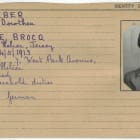
German forces occupied large parts of mainland Europe. Therefore the Channel Islands and Islanders shared a common experience of living under occupation with many other Europeans.
The Jersey Stolpersteine
One of the trails is dedicated to the Jersey Stolpersteine – which translates as stumble stones – have been laid in Jersey to remember Islanders who were persecuted during the German Occupation from 1 July 1940 to 9 May 1945. They include those oppressed for their Jewish origins, others convicted of acts of resistance or attempted escape, individuals sent to Alderney as slave labourers or interned in Germany due to being British born. This trail will help you find the locations of all the Stolpersteine and provides detailed biographies for each person. The trail itself is in two parts, one to the east of the Island and one to the west.

'Stolpersteine Trail: Martha Bernstein outside the former home of Lucy Schwob and Suzanne Malherbe.
Forced Workers’
Approximately 6,000 foreign workers – men and women – were brought to the Island against their will by the Organisation Todt (OT). Here they were made to take part in the construction of defensive concrete fortifications and sea walls, and the excavation of tunnels for artillery and ammunition storage and were often subjected to harsh conditions and near starvation.
How workers were treated depended entirely on which country they came from – all workers were exposed to dangerous working conditions and forced to work long hours with very little food. Soviet slave workers were subjected to by far the worst treatment and amongst whom were the most casualties. The Forced Workers Trail signposts places around the Island that are associated with the workers’ experience including work sites, places of punishment, buildings that formed part of the OT infrastructure as well as places of remembrance and commemoration.

Forced Workers' Trail: Slaveworkers' Memorial. Photo by Jersey Evening Post.
Liberation of Jersey
The Jersey Liberation route consists of 13 important locations related to the events of the Liberation in May 1945, or those forming part of the broader Liberation story. The route includes St Helier Harbour and Liberation Square where Islanders congregated on 9 May ‘Fauvic Embarkation Point’ on Jersey’s east coast, from where many Islanders attempted to escape during the Occupation, and the memorial on the Albert Pier to the International Red Cross ship, SS Vega, which brought much-needed supplies to a starving population.

Liberation of St Helier: V for Victory, Royal Square.
Liberation of St Helier
This trail consists of 17 special places that speak of the Islanders’ path to freedom. They include locations intimately connected to the events of the Liberation of Jersey, places where brave acts of resistance against the German Forces took place and important sites of remembrance.

Liberation of Jersey: Liberation Square













